Guanica Forest NEON (GUAN) Soil Descriptions
Distributed Soils Reports
Pedon Descriptions
Pit‐level observations and field measurements reported using the standard NRCS format. They contain volume estimates for coarse fragments > 20 mm where applicable.
Site Level Plot Summary
A narrative summary that places the sampled soil pedons in the broader context of soils and geomorphology for the entire NEON site.
Megapit Images
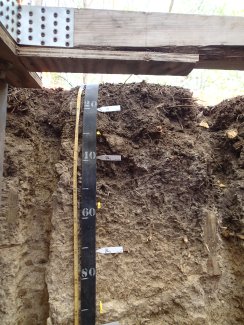
D04 GUAN megapit soil profile 0-93 cm
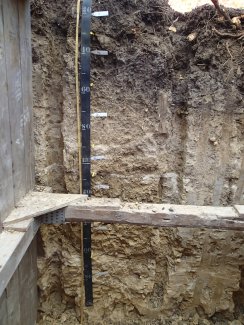
D04 GUAN megapit soil profile 13-200 cm
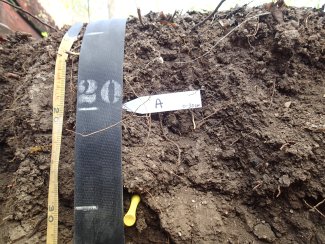
D04 GUAN megapit soil profile 0-32 cm
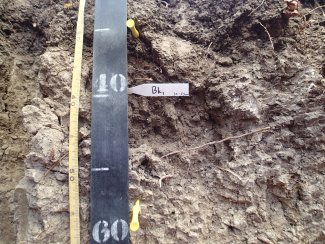
D04 GUAN megapit soil profile 25-58 cm
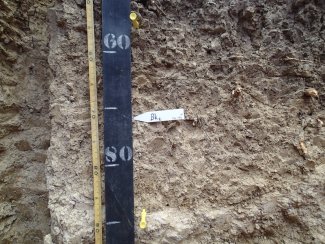
D04 GUAN megapit soil profile 51-92 cm
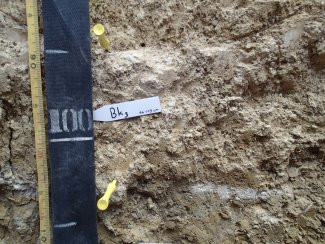
D04 GUAN megapit soil profile 84-111
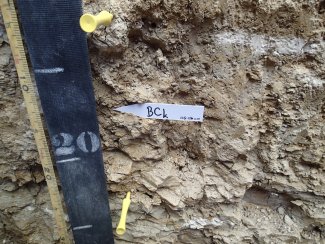
D04 GUAN megapit soil profile 104-130 cm
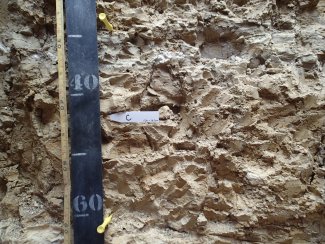
D04 GUAN megapit soil profile 124-162 cm
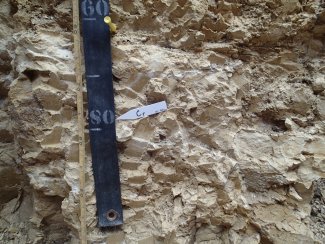
D04 GUAN megapit soil profile 156-200 cm
Megapit Pedon Description
| Print Date | Mar 11 2016 |
|---|---|
| Description Date | Apr 9 2015 |
| Describer | M. Matos, S. Rios |
| Site ID | S2015PR055001 |
| Pedon ID | S2015PR055001 |
| Lab Source ID | KSSL |
| Lab Pedon # | 15N0543 |
| Soil Name as Correlated | Altamira |
| Classification | Coarse-loamy, carbonatic, isohyperthermic Typic Haplocalcids |
| Pedon Purpose | research site |
| Taxon Kind | series |
| Associated Soils | La Covana, Seboruco |
| Physiographic Division | Caribbean Basin |
| Physiographic Province | Caribbean Islands Province |
| Physiographic Section | Greater Antilles (Puerto Rico) |
| Local Physiographic Area | Carenero Ward, Dry Forest; Guanica, Puerto Rico |
| Geomorphic Setting | on backslope of side slope of hills on backslope of side slope of hillslope |
| Upslope Shape | linear |
| Cross Slope Shape | concave |
| Description origin | NASIS |
| Country | United States |
| State | Puerto Rico |
| County | Guanica |
| MLRA | 271 -- Semiarid Mountains and Valleys |
| Soil Survey Area | PR787 -- San German Area, Southwestern Puerto Rico 3-MAZ -- Mayaguez, Puerto Rico |
| Map Unit | LcE -- La Covana-Limestone outcrop-Seboruco complex, 12 to 40 percent slopes |
| Quad Name | Punta Verraco, Puerto Rico |
| Std Latitude | 17.9688200 |
| Std Longitude | -66.8688800 |
| Latitude | 17 degrees 58 minutes 7.80 seconds north |
| Longitude | 66 degrees 52 minutes 8.00 seconds west |
| Datum | WGS84 |
| UTM Zone | 19 |
| UTM Easting | 725687 meters |
| UTM Northing | 1988033 meters |
| Primary Earth Cover | Tree cover |
| Secondary Earth Cover | Other grass/herbaceous cover |
| Parent Material | residuum weathered from limestone and siltstone |
| Bedrock Kind | limestone and siltstone |
| Description database | KSSL |
| Diagnostic Features | ochric epipedon 0 to 30 cm. calcic horizon 30 to 105 cm. |
| Slope (%) | 8.0 |
| Elevation (meters) | 133.0 |
| Aspect (deg) | 220 |
| Drainage Class | well |
| Horizon Details |
A--0 to 30 centimeters (0.0 to 11.8 inches); clay loam, dark gray (10YR 4/1) broken face, moist; strong medium granular, and strong coarse granular structure; slightly hard, firm, moderately sticky, moderately plastic; very fine roots throughout and medium roots throughout; strong effervescence, by HCl, 1 normal; slightly alkaline, pH 7.5, Unspecified; clear wavy boundary. Lab sample # 15N02901, 15N02909 Bk1--30 to 55 centimeters (11.8 to 21.7 inches); silty clay, grayish brown (10YR 5/2) broken face, moist; moderate medium subangular blocky, and moderate coarse subangular blocky structure; very hard, extremely firm, moderately sticky, very plastic; very fine roots throughout and medium roots throughout; 5 percent distinct slickensides (pedogenic) on top faces of peds; 15 percent fine prominent 10YR 8/1), moist, carbonate masses throughout and 15 percent medium prominent 10YR 8/1), moist, carbonate masses throughout; strong effervescence, by HCl, 1 normal; moderately alkaline, pH 8.0, Unspecified; gradual wavy boundary. Lab sample # 15N02902, 15N02910 Bk2--55 to 86 centimeters (21.7 to 33.9 inches); silty clay loam, light yellowish brown (2.5Y 6/4) broken face, moist; moderate fine subangular blocky, and moderate medium subangular blocky structure; moderately hard, firm, slightly sticky, moderately plastic; very fine roots throughout and medium roots throughout and fine roots throughout; 2 percent fine prominent 10YR 8/1), moist, carbonate masses throughout and 2 percent medium prominent 10YR 8/1), moist, carbonate masses throughout; violent effervescence, by HCl, 1 normal; moderately alkaline, pH 8.0, Unspecified; clear wavy boundary. Lab sample # 15N02903, 15N02911 Bk3--86 to 105 centimeters (33.9 to 41.3 inches); silty clay loam, light yellowish brown (2.5Y 6/4) broken face, moist; weak fine subangular blocky, and weak medium subangular blocky structure; moderately hard, firm, slightly sticky, moderately plastic; very fine roots throughout; 5 percent faint pressure faces on all faces of peds; 1 percent fine prominent 10YR 5/6), moist, masses of oxidized iron throughout and 1 percent medium prominent 10YR 5/6), moist, masses of oxidized iron throughout; 30 percent fine prominent 10YR 8/1), moist, carbonate masses throughout and 30 percent medium prominent 10YR 8/1), moist, carbonate masses throughout; violent effervescence, by HCl, 1 normal; moderately alkaline, pH 8.0, Unspecified; clear smooth boundary. Lab sample # 15N02904, 15N02912 BCk--105 to 126 centimeters (41.3 to 49.6 inches); silty clay loam, light yellowish brown (2.5Y 6/3) broken face, moist; weak coarse prismatic, and weak fine subangular blocky, and weak medium subangular blocky structure; very hard, extremely firm, slightly sticky, moderately plastic; very fine roots throughout; 5 percent faint pressure faces on all faces of peds; 25 percent fine prominent 10YR 5/6), moist, masses of oxidized iron throughout and 25 percent medium prominent 10YR 5/6), moist, masses of oxidized iron throughout; 2 percent fine prominent 10YR 8/1), moist, carbonate masses throughout and 2 percent medium prominent 10YR 8/1), moist, carbonate masses throughout; strong effervescence, by HCl, 1 normal; moderately alkaline, pH 8.0, Unspecified; From 105-108 cm presence of preached water table. 80% 2.5Y 6/2; 15% 10YR 8/1 horizontal carbonate masses along of the unconformity; 5% 7.5YR 4/6 iron masses between peds.; clear smooth boundary. Lab sample # 15N02905, 15N02913 C--126 to 161 centimeters (49.6 to 63.4 inches); silty clay loam, pale yellow (2.5Y 7/3) broken face, moist; weak medium subangular blocky, and weak coarse subangular blocky structure; very hard, extremely firm, slightly sticky, moderately plastic; very fine roots in cracks; 5 percent fine prominent 7.5YR 4/6), moist, masses of oxidized iron throughout and 5 percent medium prominent 7.5YR 4/6), moist, masses of oxidized iron throughout and 20 percent medium prominent 2.5Y 6/2), moist, masses of reduced iron throughout and 20 percent coarse prominent 2.5Y 6/2), moist, masses of reduced iron throughout and 25 percent fine prominent 10YR 5/8), moist, masses of oxidized iron throughout and 25 percent medium prominent 10YR 5/8), moist, masses of oxidized iron throughout; 2 percent fine prominent 10YR 8/1), moist, carbonate masses throughout and 2 percent medium prominent 10YR 8/1), moist, carbonate masses throughout; strong effervescence, by HCl, 1 normal; moderately alkaline, pH 8.0, Unspecified; From 123-131 cm presence of preached water table. 80% 2.5Y 6/2; 10% 10YR 8/1 horizontal carbonate masses along of the unconformity; 10% 7.5YR 4/6 iron masses between peds.; gradual smooth boundary. Lab sample # 15N02906, 15N02914 Cr--161 to 203 centimeters (63.4 to 79.9 inches);, pale yellow (2.5Y 7/4) broken face, moist; massive; 5 percent fine prominent 7.5YR 4/6), moist, masses of oxidized iron throughout and 5 percent medium prominent 7.5YR 4/6), moist, masses of oxidized iron throughout and 20 percent medium prominent 2.5Y 6/2), moist, masses of reduced iron throughout and 20 percent coarse prominent 2.5Y 6/2), moist, masses of reduced iron throughout and 25 percent fine prominent 10YR 5/8), moist, masses of oxidized iron throughout and 25 percent medium prominent 10YR 5/8), moist, masses of oxidized iron throughout; 15 percent fine prominent 10YR 8/1), moist, carbonate masses throughout and 15 percent medium prominent 10YR 8/1), moist, carbonate masses throughout; strong effervescence, by HCl, 1 normal; moderately alkaline, pH 8.0, Unspecified; Moderately weathered calcareous siltstone. Lab sample # 15N02907, 15N02915. |
Credits: This megapit soil pedon description was generously created by USDA Natural Resource Conservation Service staff, with particular thanks to Larry West, Jon Hempel, and numerous field staff.